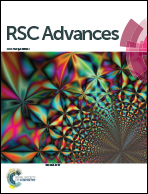Anisotropic optical properties induced by uniaxial strain of monolayer C3N: a first-principles study†
Abstract
The optical properties, structural properties and electronic properties of a new two-dimensional (2D) monolayer C3N under different strains are studied in this paper by using first-principles calculations. The applied strain includes in-layer biaxial strain and uniaxial strain. The monolayer C3N is composed of a number of hexagonal C rings with N atoms connecting them. It is a stable indirect band gap 2D semiconductor when the strain is 0%. It could maintain indirect semiconductive character under different biaxial and uniaxial strains from ε = −10% to ε = 10%. As for its optical properties, when the uniaxial strain is applied, the absorption and reflectivity along the armchair and zigzag directions exhibit an anisotropic property. However, an isotropic property is presented when the biaxial strain is applied. Most importantly, both uniaxial tensile strain and biaxial tensile strain could cause the high absorption coefficient of monolayer C3N to be in the deep ultraviolet region. This study implies that strain engineering is an effective approach to alter the electronic and optical properties of monolayer C3N. We suggest that monolayer C3N could be suitable for applications in optoelectronics and nanoelectronics.



 Please wait while we load your content...
Please wait while we load your content...